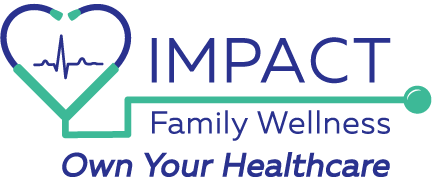Empowering Women: Spreading Awareness About Breast Self-Exams and Health Education
Breast cancer is the most common type of cancer in women. Even though it is common, many types are treatable with early detection. Increasing your breast cancer awareness and undergoing annual testing will help your physician spot early signs of cancer so you can begin treatment as soon as possible.
Impact Family Wellness has two locations, one in Cedar Park and one in Liberty Hill, Texas. The team prioritizes providing a judgment-free environment to address breast health concerns.
The Importance of Breast Self-Exams
A monthly breast self-exam helps you understand how your breasts look and feel. The more familiar you are with your breasts, the more likely you are to notice subtle changes and discuss them with your care team.
A self-exam can’t detect all signs of breast cancer, but it is a valuable tool for early detection. If you discuss changes in your breasts with your physician, they can order further testing to determine whether there is a cause for concern.
Doing a Breast Self-Exam
Part of breast cancer awareness includes knowing the best way to conduct a breast self-exam. A thorough exam includes visual and manual components.
Visual Exam
Start by standing in front of a mirror without a shirt or bra. Raise and lower your arms, watching for puckering, changes in shape, or other unusual characteristics.
Manual Exam
For the manual part of the breast self-exam, lie down on your bed or another flat surface. Use your fingers to feel for lumps. Start from the nipple and go outward, focusing on one direction at a time. Go over each area more than once, using varying degrees of pressure.
If you notice any lumps, ridges, or other unusual characteristics, discuss them with your physician as soon as possible. They will evaluate the area with a clinical exam to determine whether you need special imaging.
Breast Imaging for Early Detection
If you’re over age 40 or you’re younger but have qualifying risk factors, you should undergo yearly mammograms. These simple, outpatient imaging tests give the radiologist a close look at your breast tissue to spot signs of cancer.
Lowering Your Risk For Breast Cancer
There are some factors you can’t change, including age, gender, and carrying the BRCA gene mutation. Cisgender women over age 50 are at an increased risk for breast cancer. Even so, there are some factors you can control that could contribute to a lower risk of developing breast cancer and other illnesses.
Regular exercise can help you lose weight, which lowers the risk of heart disease, type 2 diabetes, and breast cancer. It can also help reduce inflammation and increase your range of motion, which could mean you experience less pain as you age.
Lowering alcohol consumption has many benefits. If you’re trying to lose weight, it will help you stay in a calorie deficit. It also helps your liver and other organs stay healthy and lowers your risk of developing cancer.
As you age, you could run a higher risk of developing breast cancer if you use birth control pills or hormone replacement therapy. Always discuss the risks with your medical team, especially if you have other existing risk factors.
Women’s Health Issues Beyond Breast Cancer
Breast cancer isn’t the only thing to keep in mind regarding women’s medical care.
There are other areas to monitor during routine exams, including the following:
- Heart: The leading cause of death in women is heart disease. Regular medical appointments help your physician identify early signs of heart disease.
- Bones: After menopause, women are likely to develop osteoporosis, which can result in frequent broken bones. A physician can recommend vitamin supplements and other methods to increase bone density.
- Reproductive system: Problems with the ovaries or cervix can develop over time. Regular Pap smears and pelvic exams can detect early signs of disease.
- Mental health: It’s easy to forget about mental health, focusing solely on physical health during medical exams. Mental health can manifest as physical symptoms. If you think you need mental health treatment, don’t hesitate to bring it up during your next exam.
Tips for Better Health
Women have more to worry about than breast health. Seeing a physician regularly allows you to address all sorts of concerns, so take advantage of these visits to bring any worries you might have to a medical professional’s attention.
Wellness Visits
You schedule a medical appointment when you’re sick. Depending on their severity, symptoms like a fever, sore throat, and cough could require medical attention. Scheduling annual physical and other wellness visits helps your physician identify signs of illness and can even contribute to cancer prevention.
Nutrient-Rich Diet
A diet rich in nutrients, protein, and healthy fats contributes to breast health and overall well-being. When you give your body the types of foods it needs to thrive, you will begin to feel better and have more energy.
Stress Management
Chronic stress can manifest itself in many ways, including illness and an overall decreased quality of life. Your physician can help you with stress management techniques to reduce secondary problems caused by stress.
Reduce Alcohol Consumption
Some women cope with stress and other problems by utilizing alcohol. Over time, chronic alcohol use has many negative effects on the body, including increased cancer risk.
Access to Breast Cancer Resources With Impact Family Wellness
Early detection is the best way to effectively begin treating breast cancer. Breast self-exams followed by a clinical exam and breast imaging can detect early signs of breast cancer and help your team form a proactive treatment plan. In addition to regular exams, patients can reduce their risk by exercising more, adding nutritious fruits and vegetables to their diet, and reducing alcohol consumption.
Impact Family Wellness has locations in Cedar Park and Liberty Hill. The team aims to increase breast cancer awareness by providing a non-judgmental space for patients to discuss breast health with their providers. To schedule a breast exam, lab work, or any other type of appointment, call
512-537-2177.










